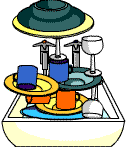Dish Sculptures
Created | Updated Jan 7, 2012

Imagine walking into a kitchen and seeing a sink full of dishes. Not a very unusual situation, but in this case something isn't quite right. The dishes look as if someone had spent hours arranging the various pieces. A large pot sits at the bottom of the sink. Two small cups sit in the pot, and a plate rests on top of the cups. A bowl sits on the plate, a large cup in the bowl, and another plate on the cup. One last bowl stands at the top, with several spoons and forks in it. Various additional cups surround the whole structure, and every flat surface is covered with water. And the wonderful thing about this arrangement is that there appears to be room for one more cup, perhaps the one you just finished drinking out of.
Dish sculptures are common in kitchen sinks worldwide, especially those without dishwashers. The art of dish sculpting has come into existence for two reasons:
- Most folks dislike cleaning up after a meal.
- Dishes with dried-on food are tough to clean.
By creating a dish sculpture, you can avoid cleaning the dirty dishes, pots, pans, and cups from several consecutive meals. The trick lies in stacking these items level and filling them with water, in order to prevent the food from sticking. When it is finally time to clean up, the task will be no more difficult than if the dishes had just been used. A creative, expert sculptor can continue adding to the sculpture for many days, until the sink is full or the dishes have run out.

